35.3 Scheduling an Application Pre-Install
Scheduling a pre-install enables you to perform an off-line, or lights-out, distribution of the application and save the user some of the wait typically associated with a distribution. For example, you could pre-install an application after work hours so the application is ready to use the next day.
For user-associated applications to be pre-installed at the schedule time, Application Launcher must be running on the user's workstation
For workstation-associated applications to be pre-installed at the scheduled time, Application Launcher does not need to be running. Pre-install tasks are handled by the NAL Workstation Helper, running under the Workstation Manager.
-
In ConsoleOne, right-click the Application object that you want to pre-install, then click to display the Application object's property pages.
-
Click the tab > to display the Pre-Install Schedule page.
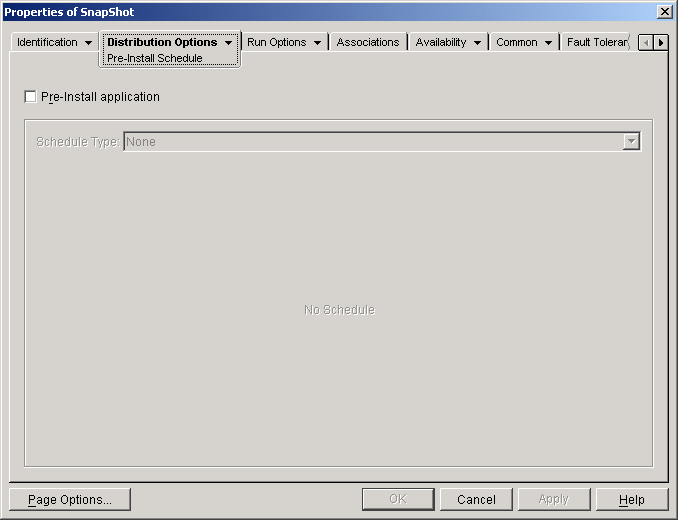
-
Select the check box to enable the option.
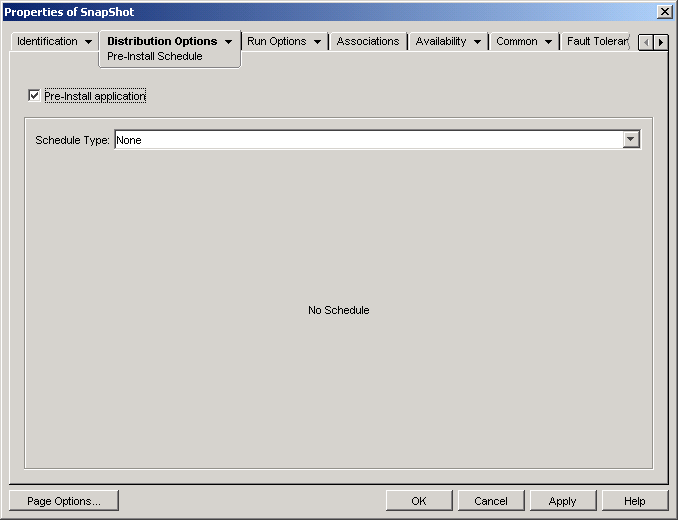
There are two schedule types for you to choose from: and .
-
Specified days: Use this schedule type to designate specific days and times when the application can be pre-installed. You can specify up to 350 different days and times.
-
Range of days: Use this schedule type to designate a range of days each week that the application can be pre-installed.
-
-
(Conditional) To use the specified days schedule, complete Step 4.a through Step 4.c. Otherwise, to use the range of days schedule, skip to Step 5.
-
In the list, select to display the Specified Days options.
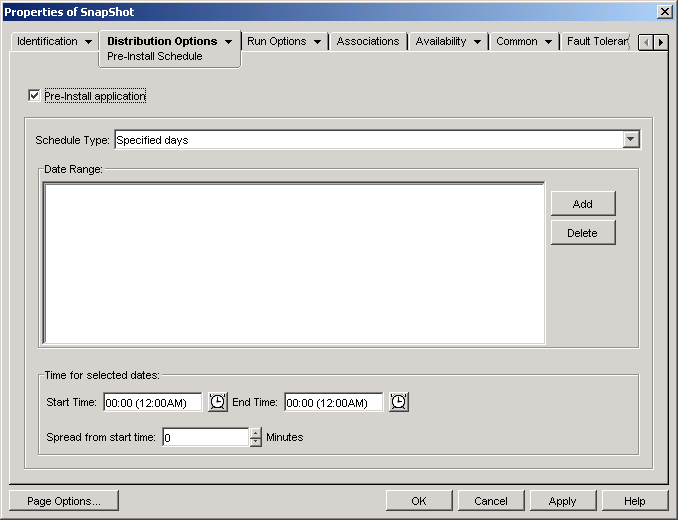
-
Fill in the following fields:
-
Date range: The Date Range list displays all dates when the application can be pre-installed. To add a date, click Add, select the date you want, then click OK to display it in the list.
-
Time for selected dates: Select the availability start time and end time. The times apply to all dates in the list.
NOTE:The time increments in 5 minute intervals, with the earliest available start time being 00:00 (12:00 a.m.) and the latest end time being 23:55 (11:55 p.m.). This means there is always a 5-minute time period from 11:55 p.m. to 12:00 midnight when the application is unavailable. If you want the application to be available the entire day, you need to use the schedule type. For more information, see Step 5.b.
-
Spread from start time (in minutes): The option spreads out user access times over the number of minutes specified so the application doesn’t become available to all users at the same time. If you anticipate all users launching the application as soon as it becomes available and the application is being distributed or run from the network, you can use this option to avoid possible network overload.
For example, if you have a moderate number of users to whom the application is to be distributed (say about 100), you might specify a one-hour (60 minute) block of time (starting at the scheduled start time) to randomly distribute the application: thus all users will gain access to the application some time during the first sixty minutes after the scheduled start time.
If you want to substantially ease the load on your servers caused by the application distribution, or if you have bandwidth concerns, you might want to make the application distribute randomly throughout the time of availability. To spread out access times across the entire time ( and ) that the application is available, use the total availability time specified for that application in terms of minutes. This will require that you make the maximum time available for each day you specify. For example, if an application is configured for a typical business day in the United States (9 hours per day: 8:00 a.m. to 5:00 p.m.), you calculate the total time of availability for that application like this:
Number of specified hours x 60 minutes per hour = Total availability time per day
Using this equation, the example above would be calculated like this:
9 x 60 (minutes per hour) = 540 minutes of availability per day
In this example, when you enter 540 minutes in the field, the application is distributed randomly for the entire 540 minutes that you have made it available on that scheduled day. Note that this might not be suitable for applications that must be distributed in a timely fashion, such as anti-virus updates. Note also that this is an example only: you can schedule the distribution for any specified amount of time for any day of the week.
Remember that the setting makes the last five minutes of a day unscheduleable, so you need to consider these five minutes if the application schedule ends at 11:55 p.m. for that day.
-
-
Continue with Step 6.
-
-
(Conditional) To use the schedule, complete Step 5.a through Step 5.c. Otherwise, to use the schedule, return to Step 4.
-
In the list, select to display the options.
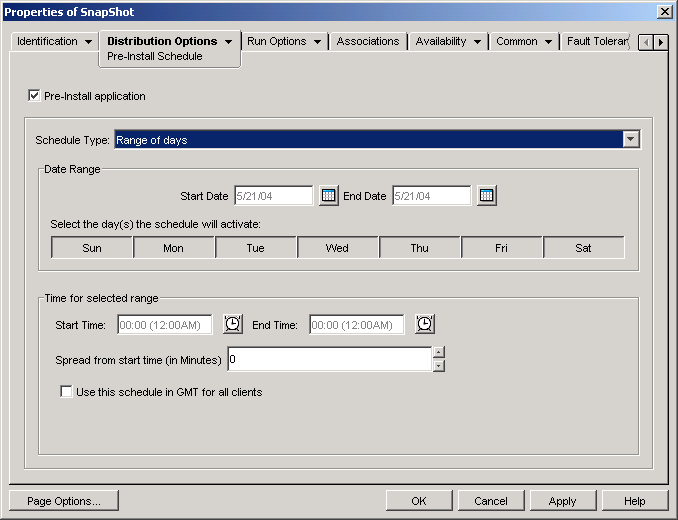
-
Fill in the following fields:
-
Date range: To define the range of days, select a start date and an end date, then select the days (Sunday through Saturday) within the established date range. By default, all days are selected; a day is selected when the button appears to be pressed in.
-
Time for selected range: Select the availability start time and end time. This option works differently depending on whether the date range includes one day, multiple days, or all seven days. If the date range includes one to six days (but not all seven days), the application is available between the start and end times on those days. For example, if you make the application available on Monday between 8:00 and 5:00, it is available during those hours. However, if the date range includes all seven days, the times are ignored and the application is available every day, 24 hours a day.
-
Spread from start time (in minutes): The option spreads out user access times over the number of minutes specified so the application doesn’t become available to all users at the same time. If you anticipate all users launching the application as soon as it becomes available and the application is being distributed or run from the network, you can use this option to avoid possible network overload.
For example, if you have a moderate number of users to whom the application is to be distributed (say about 100), you might specify a one-hour (60 minute) block of time (starting at the scheduled start time) to randomly distribute the application: thus all users will gain access to the application some time during the first sixty minutes after the scheduled start time.
If you want to ease the load of the application distribution on your servers or if you have bandwidth concerns, you might want to make the application distribute randomly throughout the time of availability. To spread out access times across the entire time ( and ) that the application is available, use the total availability time specified for that application in terms of minutes. For example, if a workstation-associated application is configured for an entire 24-hour, three-shift day, you can calculate the total time of availability for that application like this:
Number of days in date range x Time of availability per day = Total availability time
Using this equation, and making sure to convert hours to minutes, the example above would be calculated like this:
7 (days) x 24 (hours) = 168 hours of availability
168 x 60 (minutes per hour) = 10,080 minutes of availability
When you enter 10800 minutes in the field, the application is distributed randomly for the entire10800 minutes that you have made it available. Note that this is not suitable for applications that must be distributed in a timely fashion, such as anti-virus updates.
-
Use this schedule in GMT for all clients: The schedule is based on the workstation’s time zone. If your network spans different time zones and you schedule an application to run at 1:00 p.m., it runs at 1:00 p.m. in each time zone. You can select this option to have workstations run applications at the same time regardless of their time zones (for example, 1:00 p.m. Rome time and 4:00 a.m. Los Angeles time).
-
-
Continue with Step 6.
-
-
(Conditional) If you are pre-installing a workstation-associated MSI application and you want to use the workstation's credentials used rather than the logged-in users, you must enable the option.
By default, workstation-associated MSI applications are distributed in the user security space, meaning that Application Launcher uses the user's credentials and file system access. If you want to perform a lights-out distribution without requiring the user to remain logged in at the workstation, you can have Application Launcher turn over distribution to the NAL Workstation Helper, which runs in the system space and uses the workstation’s credentials.
Not all MSI applications can be installed using the workstation's credentials. Some MSI applications have dependencies on a logged-in user (for example, to read and write to the HKCU hive in the Windows registry). In this situation, you must deselect this option in order to have the distribution occur in the user security space and not the workstation security space.
To enable pre-install using the workstation's credentials:
-
Click the tab > to display the Options page.
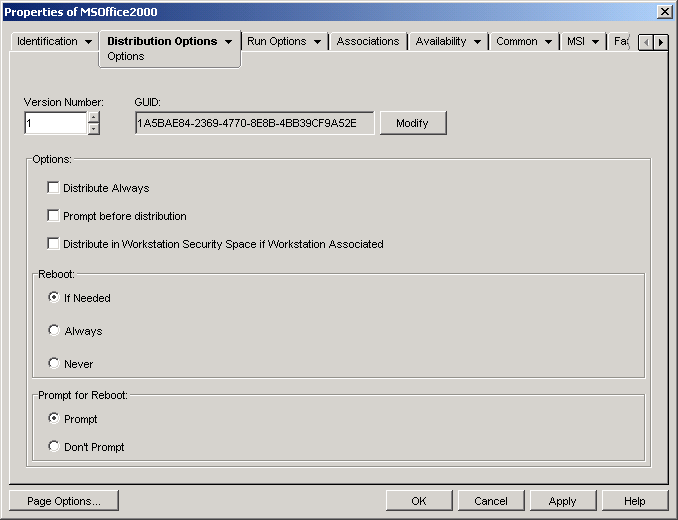
-
Select the check box to enable the option.
It is important to remember that NAL Workstation Helper uses the workstation’s credentials, not the user's credentials, to distribute the application. This means that you must assign the workstation the appropriate file system rights to access the network location where the source .msi files reside.
If an application requires a reboot during installation, you must select or in the group box and in the group box.
-
-
Click to save your changes.